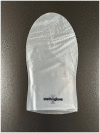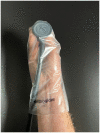A clinical study to evaluate the safe and effective use of a new, single use stethoscope cover to enable reduction in pathogen transmission during auscultation
- PMID: 37425319
- PMCID: PMC10324409
- DOI: 10.3389/fmed.2023.1179145
A clinical study to evaluate the safe and effective use of a new, single use stethoscope cover to enable reduction in pathogen transmission during auscultation
Abstract
Objectives: Stethoscopes carry a significant risk for pathogen transmission. Here, the safe use and performance of a new, non-sterile, single-use stethoscope cover (SC), that is impermeable for pathogens, was investigated by different healthcare professionals (HCPs) in the postoperative care setting of an intensive care unit (ICU).
Methods: Fifty-four patients underwent routine auscultations with the use of the SC (Stethoglove®, Stethoglove GmbH, Hamburg, Germany). The participating HCPs (n = 34) rated each auscultation with the SC on a 5-point Likert scale. The mean ratings of acoustic quality and the SC handling were defined as primary and secondary performance endpoint.
Results: 534 auscultations with the SC were performed (average 15.7/user) on the lungs (36.1%), the abdomen (33.2%), the heart (28.8%), or other body-sites (1.9%). No adverse device-effects occurred. The acoustic quality was rated at 4.2 ± 0.7 (mean) with a total of 86.1% of all auscultations being rated at least as 4/5, and with no rating as below 2. The SC handling was rated at 3.7 ± 0.8 (mean) with a total of 96.4% of all auscultations being rated at least 3/5.
Conclusion: Using a real-world setting, this study demonstrates that the SC can be safely and effectively used as cover for stethoscopes during auscultation. The SC may therefore represent a useful and easy-to-implement tool for preventing stethoscope-mediated infections.Study Registration: EUDAMED no. CIV-21-09-037762.
Keywords: auscultation; nosocomial infections; polymer; stethoscope; transmission.
Copyright © 2023 Nazari-Shafti, Meyborg, Iske, Schloss, Seeber, Friedrich, Exarchos, Richter, Falk and Emmert.
Conflict of interest statement
ME is a scientific advisor to Stethoglove GmbH. Outside the submitted work: VF has relevant (institutional) financial activities with following commercial entities: Medtronic GmbH, Biotronik SE & Co., Abbott GmbH & Co. KG, Boston Scientific, Edwards Lifesciences, Berlin Heart, Novartis Pharma GmbH, JOTEC GmbH and Zurich Heart in relation to educational Grants (including travel support), fees for lectures and speeches, fees for professional consultation and research and study funds. The remaining authors declare that the research was conducted in the absence of any commercial or financial relationships that could be construed as a potential conflict of interest.
Figures




Similar articles
-
Real-world evaluation of the Stemoscope electronic tele-auscultation system.Biomed Eng Online. 2022 Sep 6;21(1):63. doi: 10.1186/s12938-022-01032-4. Biomed Eng Online. 2022. PMID: 36068509 Free PMC article.
-
Brief report: pulmonary auscultation in the operating room: a prospective randomized blinded trial comparing electronic and conventional stethoscopes.Anesth Analg. 2013 Sep;117(3):646-648. doi: 10.1213/ANE.0b013e31829ec0a5. Epub 2013 Jul 18. Anesth Analg. 2013. PMID: 23868885 Clinical Trial.
-
A simulator-based study of in-flight auscultation.Simul Healthc. 2014 Apr;9(2):81-4. doi: 10.1097/SIH.0b013e3182a833e0. Simul Healthc. 2014. PMID: 24695079 Clinical Trial.
-
The 200th anniversary of the stethoscope: Can this low-tech device survive in the high-tech 21st century?Eur Heart J. 2016 Dec 14;37(47):3536-3543. doi: 10.1093/eurheartj/ehw034. Epub 2016 Feb 22. Eur Heart J. 2016. PMID: 26908946 Review.
-
Review on the Advancements of Stethoscope Types in Chest Auscultation.Diagnostics (Basel). 2023 Apr 25;13(9):1545. doi: 10.3390/diagnostics13091545. Diagnostics (Basel). 2023. PMID: 37174938 Free PMC article. Review.
Cited by
-
Investigating stethoscope hygiene practices and bacterial contamination among medical trainees: an educational perspective.Sci Rep. 2025 Jul 2;15(1):23444. doi: 10.1038/s41598-025-07231-y. Sci Rep. 2025. PMID: 40603445 Free PMC article.
-
Implementation of stethoscope disinfection: an observational study on nursing staff practice and knowledge.GMS Hyg Infect Control. 2024 May 17;19:Doc30. doi: 10.3205/dgkh000485. eCollection 2024. GMS Hyg Infect Control. 2024. PMID: 38883408 Free PMC article.
References
-
- Amin A. Keeping the stethoscope, the Clinician’s third hand. Clean Infection Control Today. (2021) 25:26–7.
LinkOut - more resources
Full Text Sources

